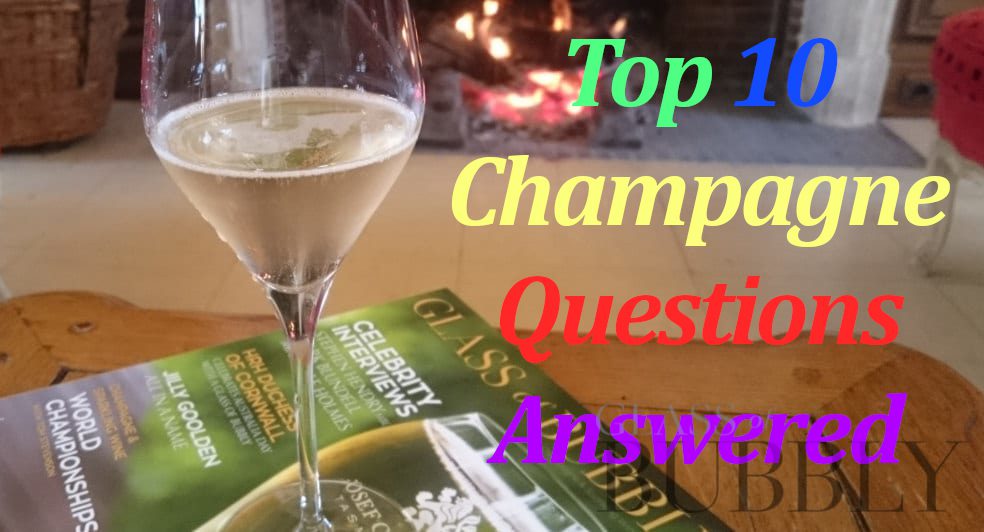Top 10 Champagne Questions Answered
9th May 2022

Let’s dive into 10 of the most frequently asked questions about Champagne and give you the answers with the best explanations.
1 – Can All Sparkling Wine Be Called Champagne?
No, Champagne can only be called Champagne if it was produced in the Champagne region in the Northeast of France.
2 – What Does ‘Brut’ Mean?
Brut is referring to the sweetness level inside the bottle, Brut is the most common sugar level in a bottle of Champagne.
- Brut Natural or Brut Zero – less than 3 grams of sugar per litre or no sugar at all.
- Extra Brut – less than 6 grams of sugar per litre.
- Brut – less than 12 grams of sugar per litre.
- Extra Dry – up to 17 grams of sugar.
- Dry – up to 32 grams of sugar.
- Demi-Sec – up to 50 grams of sugar.
- Doux – more than 50 grams.
3 – How To Keep Champagne Bubbly?
Once you open a bottle of Champagne you can lose up to 80% of the CO2 inside the bottle, that’s if you let the cork fly, its a bit less if you open it with a whisper, the best way to keep the bubbles inside the bottle is to use a bottle stopper, but if you don’t have one of them in your home, you can use a metal teaspoon, place the handle in the bottleneck and this help reduce slightly the loss of bubbles.
4 – How Long Can I Keep A Bottle Of Champagne Open?
If stored in your fridge, then between 3-5 days before it starts going flat.
5 – What is the Best Temperature to Serve Champagne?
Between 8-10 degrees is best to enjoy a bottle of Champagne, some people even prefer up to 12 degrees, however, Sparkling Red Wine is best to have well chilled.
6 – How Should Your Store Champagne?
The best way to store your bottles of Champagne is in a dark and cool place, somewhere where the temperature is consistent rather than going from hot and cold all the time. Don’t store in direct sunlight and don’t leave in hot places like next to a radiator.
7 – Does Champagne Pair Well with Food?
Yes, it can pair perfectly, some Champagne and food pairings enhance both the Champagne and the Dish, others have the Champagne enhance the Dish or the Dish enhance the Champagne, you can receive added flavours from the Champagne or discover subtle flavours from the Dish, it all depends on the Champagne and the Dish.
Pairing Champagne with Traditional Chinese Cuisine
The Finest Champagne & Sparkling Wines with Recommended Food Pairings
8 – Is All Champagne The Same?
No, each Champagne house, big or small has there own style, different vintage years display characters, you can find flavours such as toasty, brioche, yeasty, biscuity, yellow fruits, citrus, minerals and much more.
9 – Is Vintage Champagne Better Than Non-Vintage?
Vintage Champagne means that all the grapes in the bottle were grown, harvested and pressed in the same year, Vintage on a bottle can mean a superior quality because all the grapes are normally determined to be an overall superior quality and a winemaker may put extra special attention towards it and you are more likely to need to spend more on a good vintage, but not all vintages are better than Non-Vintage, some grower Champagne houses produce some great Non-Vintage Champagnes which sometimes taste better than a particular Vintage Year, with each new Vintage year, you could see a change in flavours and aromas, meaning that not all vintages are going to taste the same.
10 – Are Champagne and Prosecco The Same?
No, Champagne comes from the Champagne region in France and Prosecco comes from the Prosecco region in Italy, they are also made in different ways, with Champagne using the Traditional/Classic Method and Prosecco using the quicker Charmat/Tank Method, which gives them different flavours and aromas, you should be able to easily tell a glass of Champagne from Prosecco apart.
![]()
Oliver Walkey
Champagne and Sparkling Wine Writer, Focused on Bringing the Exciting and Fascinating World of Bubbly to You.
